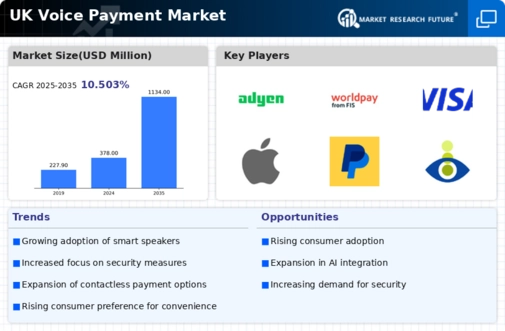Increased Focus on Personalization
Personalization is becoming a crucial aspect of the voice payment market, as businesses strive to tailor their offerings to individual consumer preferences. The ability to recognize and respond to unique user voices allows companies to create customized payment experiences, which can enhance customer satisfaction and loyalty. Recent studies indicate that 70% of consumers are more likely to engage with brands that offer personalized services. This trend is particularly relevant in the voice payment market, where understanding consumer behavior can lead to more effective marketing strategies and improved transaction rates. As businesses invest in data analytics and machine learning to better understand their customers, the potential for personalized voice payment solutions is likely to grow, fostering deeper connections between brands and consumers.
Rising Consumer Demand for Convenience
The voice payment market is experiencing a notable surge in consumer demand for convenience. As individuals increasingly seek seamless and efficient payment methods, the adoption of voice-activated transactions is becoming more prevalent. Recent surveys indicate that approximately 60% of UK consumers express a preference for hands-free payment solutions, highlighting a shift towards more user-friendly interfaces. This trend is particularly pronounced among younger demographics, who are more inclined to embrace innovative technologies. The voice payment market is thus positioned to capitalize on this growing demand, as businesses strive to enhance customer experiences by integrating voice technology into their payment systems. Furthermore, the convenience factor is likely to drive higher transaction volumes, potentially leading to increased revenue streams for companies operating within this sector.
Growing Integration with Smart Home Devices
The integration of voice payment systems with smart home devices is emerging as a key driver in the voice payment market. As households increasingly adopt smart technology, the potential for voice-activated payments through devices such as smart speakers and home assistants is expanding. Reports indicate that the UK market for smart home devices is projected to reach £10 billion by 2026, suggesting a robust environment for voice payment solutions. This integration not only enhances user convenience but also creates new opportunities for retailers and service providers to engage with consumers in innovative ways. The voice payment market is likely to benefit from this trend, as more consumers become accustomed to using their voices for various tasks, including making purchases. Consequently, the synergy between smart home technology and voice payments could lead to a significant increase in transaction volumes.
Advancements in Voice Recognition Technology
Technological advancements in voice recognition are significantly influencing the voice payment market. Enhanced accuracy and speed of voice recognition systems are making it easier for consumers to engage in transactions using their voices. Recent developments suggest that the accuracy of voice recognition technology has improved to over 95%, which is crucial for building consumer trust in voice-activated payments. This progress is likely to encourage more businesses to adopt voice payment solutions, as the voice payment market becomes increasingly competitive. Moreover, the integration of artificial intelligence and machine learning into voice recognition systems is expected to further refine user experiences, making transactions smoother and more reliable. As these technologies continue to evolve, they may play a pivotal role in shaping the future landscape of the voice payment market.
Regulatory Support for Digital Payment Solutions
Regulatory support for digital payment solutions is playing a pivotal role in the growth of the voice payment market. The UK government has been actively promoting digital payment methods to enhance financial inclusion and streamline transactions. Recent initiatives aimed at simplifying compliance for digital payment providers are expected to encourage more businesses to adopt voice payment technologies. This supportive regulatory environment is likely to foster innovation within the voice payment market, as companies seek to develop new solutions that align with government objectives. Furthermore, as regulations evolve to accommodate emerging technologies, the voice payment market may witness accelerated growth, driven by increased consumer confidence and a broader acceptance of digital payment methods.






















Leave a Comment